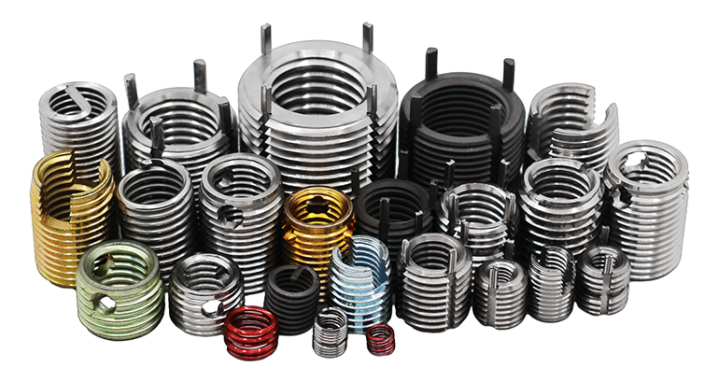
Inserció de bloqueig de clau,self-tapping insert,Inserció de rosca de filferro
Threaded inserts are essential components in various industries, offering reliable solutions for creating strong and durable threaded connections in a wide range of materials. Whether you are working on a DIY project or managing a complex manufacturing process, choosing the right threaded inserts is crucial to ensure the integrity of your threaded connections. In this comprehensive guide, we’ll walk you through the essential factors to consider when selecting threaded inserts for your specific needs.
Compatibilitat de materials
The first and foremost consideration when choosing threaded inserts is material compatibility. The insert material should be compatible with both the host material (the material you are inserting the insert into) and the fastener material (the screw or bolt you intend to use). Common materials for threaded inserts include stainless steel, brass, aluminum, and various plastics. Ensure that the chosen insert material offers corrosion resistance, mechanical strength, and thermal compatibility with the host material.
Type of Threaded Insert
Threaded inserts come in various types, each designed for specific applications. The main types include:
1. Helical Inserts (Free-Running Inserts): Ideal for applications where ease of installation and versatility are paramount. They distribute loads evenly and can be removed and reused.
2. Screw-Locking Inserts: Designed for applications where vibrational loosening is a concern. These inserts provide a secure, permanent connection and resist vibration and shock.
3. Insercions sense Tangless: These inserts eliminate the need for a tang (a protruding end) that must be broken off after installation, making them convenient and reducing the risk of FOD (foreign object debris).
4. Key-Locking Inserts: Known for their high-strength, these inserts feature keys or locking rings that lock into the host material, providing exceptional torque and pull-out resistance.
Select the type of threaded insert that aligns with the specific requirements of your application, whether it’s ease of installation, resistance to vibration, or high-strength requirements.
Size and Thread Size
Threaded inserts come in various sizes to accommodate different thread sizes and hole diameters. Ensure that you select inserts with the appropriate size and thread size that match your fasteners. Mismatched sizes can lead to improper threading and compromise the integrity of the connection.
Application Environment
Consider the environmental conditions in which the threaded inserts will be used. For outdoor or corrosive environments, stainless steel inserts provide excellent corrosion resistance. In high-temperature applications, choose inserts that can withstand elevated temperatures without compromising their structural integrity.
Installation Method
The method of installation can vary depending on the type of threaded insert. Some inserts require specialized tools or equipment for installation, while others can be installed using basic hand tools. Ensure that you have access to the necessary tools and equipment to install the inserts correctly.
Load and Torque Requirements
Determine the load-bearing and torque requirements of your application. Different threaded inserts have varying load-carrying capacities and torque resistance. It’s essential to choose inserts that can handle the expected loads and torques without failure.
Cost Considerations
While quality and performance should be the primary considerations, it’s also essential to factor in the cost of the threaded inserts, especially for large-scale manufacturing or budget-sensitive projects. Compare the cost of different inserts while keeping in mind the long-term benefits they offer in terms of reliability and durability.
Installation Expertise
Consider the level of expertise available for the installation of threaded inserts. Some types of inserts may require more skill and experience to install correctly. Ensure that your team or the individuals responsible for installation are knowledgeable and trained in the proper installation techniques.
Choosing the right threaded inserts involves careful consideration of material compatibility, insert type, size, environmental conditions, installation method, load requirements, cost, and installation expertise. By taking these factors into account, you can select the threaded inserts that will ensure the integrity and durability of your threaded connections, whether you’re working on a DIY project or managing a complex industrial application. Making the right choice in threaded inserts can lead to stronger and more reliable connections, reducing maintenance and replacement costs in the long run.
 Insercions de fil Fabricant de la Xina
Insercions de fil Fabricant de la Xina

WeChat
Escaneja el codi QR amb wechat